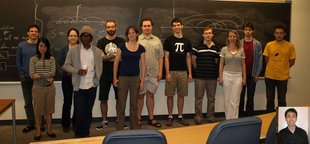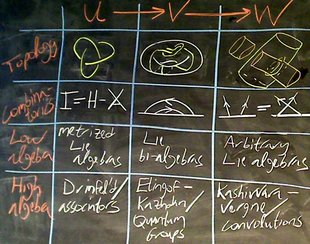AKT-09/About This Class
| ||||||||||||||||||||||||||||||||||||||||||||||||||||||
Crucial Information
Agenda: Understand "(u, v, and w knots) x (topology, combinatorics, low algebra, and high algebra)". Understand the promise and the difficulty of the not-yet-existant "Algebraic Knot Theory".
Instructor: Dror Bar-Natan, drorbn@math.toronto.edu, Bahen 6178, 416-946-5438. Office hours: by appointment.
Classes: Tuesdays 10-11 in 215 Huron room 1018 and Thursdays 9-11 in Bahen 6183.
URL https://drorbn.net/drorbn/index.php?title=AKT-09.
Abstract 1
Our subject is a Cartesian product. It runs in three parallel columns - the u column, for usual knots, the v column, for virtual knots, and the w column, for welded, or weakly virtual, or warmup knots. Each class of knots has a topological meaning and a "finite type" theory, which leads to some combinatorics, somewhat different combinatorics in each case. In each column the resulting combinatorics ends up describing tensors within a different "low algebra" universe - the universe of metrized Lie algebras for u, the richer universe of Lie bialgebras for v, and for w, the wider and therefore less refined universe of general Lie algebras. In each column there is a "fundamental theorem" to be proven (or conjectured), and the means, in each column, is a different piece of "high algebra": associators and quasi-Hopf algebras in one, deformation quantization à la Etingof and Kazhdan in the second, and in the third, the Kashiwara-Vergne theory of convolutions on Lie groups. Finally, u maps to v and v maps to w at topology level, and the relationship persists and deepens the further down the columns one goes.
The 12 boxes in this product each deserves its own set of talks, and the few that are not yet fully understood deserve a few further years of research. I really hope we will at least get a taste of the contents the (2,4) box, the one I understand the least and the one I wish to understand the most.
Abstract 2
An "Algebraic Knot Theory" should consist of two ingredients
- A map taking knots to algebraic entities; such a map may be useful, say, to tell different knots apart.
- A collection of rules of the general nature of "if two knots are related in such and such a way, their corresponding algebraic entities are related in such and such a way". Such rules may allow us, say, to tell how far a knot is from the unknot or how far are two knots from each other.
(If you have seen homology as in algebraic topology, recall that its strength stems from it being a functor. Not merely it assigns groups to spaces, but further, if spaces are related by maps, the corresponding groups are related by homomorphisms. We seek the same, or similar, for knots.)
The first ingredient for an "Algebraic Knot Theory" exists in many ways and forms; these are the many types and theories of "knot invariants". There is very little of the second ingredient at present, though when properly generalized and interpreted, the so-called Kontsevich Integral seems to be it. But viewed from this angle, the Kontsevich Integral is remarkably poorly understood.
The purpose of this class will be to understand all of the above.
Abstract 3
Like number theory, knot theory is really just an excuse. For this class, it is mostly an excuse to study the surprisingly rich algebra around finite type invariants and some combinatorial mathematics that underlies the theory of Lie algebras. Yet we will sometimes use our excuse to take a 1-class excursion going elsewhere: Categorification, maybe. Path integrals, maybe. The four colour theorem, perhaps. Other things, I hope.
Warning
This class is not for everyone. An old rule says one should not give a class on one's own current research. Here we will break that rule with vengeance - the class won't just be about current research, it will be about research that had not been done yet. Our purpose will not be to paint a beautiful picture of an established field, rather, to learn about the parts that may one day fit into and create such a beautiful picture, or may not. The parts are pretty in themselves and will force us to tour a number of deep mathematical fields. But by the nature of things, the presentation may well be confused and frustrating. If that scares you, or if all you need is a sure credit, do not take this class.
Prerequisites
The graduate core classes in topology and in algebra, or anything equivalent to that.
Videos and Wiki
Since very much of the content of the class is not in the books, We will videotape all classes and the course's web site will be centered around these videos. I have set up a system that allows anyone signed-up to index and annotate these videos on a wiki (as in Wikipedia), and allows for the inclusion and linking of other pages and further material to this wiki.
Anyone signed-up can, is welcome and is encouraged to edit and add to the class' web site. In particular, students can post video annotations, notes, comments, pictures, solution to open problems, whatever. Some rules, though -
- This wiki is a part of my (Dror's) academic web page. All postings on it must be class-related (or related to one of the other projects I'm involved with).
- Criticism is fine, but no insults or foul language, please.
- I (Dror) will allow myself to exercise editorial control, when necessary.
- The titles of all pages related to this class should contain and preferably begin with the string "AKT-09", just like the title of this page.
Email me with you full name, email address and preferred userid if you need an account on the class wiki. Some further editing help is available at Help:Contents.
Homework
There will be 4-5 problem sets. I encourage you to discuss the assignments with other students or even browse the web, so long as you do at least some of the thinking on your own and you write up your own solutions.
Good Deeds and The Final Grade
Your "bare" final grade will be a 50-50 average of your homework grade and your final exam grade.
In addition, you will be able to earn up to 60 "good deeds" points throughout the year for doing services to the class as a whole. There is no pre-set system for awarding these points, but the following will definitely count:
- Solving an open problem.
- Giving a class on one subject or another.
- Annotating the class videos. This would be especially useful! Videos without an index are generally useless; it is impossible to search for that particular lemma whose proof you want. Thus every video page for this class should eventually have around a one sentence summary for each 2-3 minutes of play time.
- Drawing a beautiful picture to illustrate a point discussed in class and posting it on this site.
- Taking class notes in nice handwriting, scanning them and posting them on the class web site.
- Formatting somebody else's class notes, correcting them or expanding them in any way.
- Writing an essay on expanding on anything mentioned in class and posting it here; correcting or expanding somebody else's article.
- Doing anything on our |to do list.
- Any other service to the class as a whole.
Good deed points will count towards your final grade! If you got of those, they are solidly your and the formula for the final grade below will only be applied to the remaining points. So if you got 40 good deed points (say) and your "bare" final grade is 80, I will report your grade as . Yet you can get an overall 100 even without doing a single good deed.
Important. For your good deeds to count, you must do them under your own name. So you must set up an account for yourself on this wiki and you must use it whenever you edit something. I will periodically check Recent changes to assign good deeds credits.
Class Photo
To help me learn your names, I will take a class photo on Thursday of the third week of classes. I will post the picture on the class' web site and you will be required to send me an email and identify yourself in the picture or to identify yourself on the Class Photo page of this wiki.












